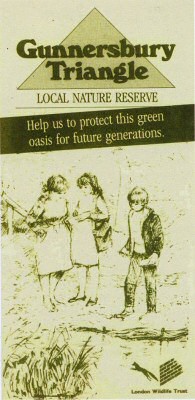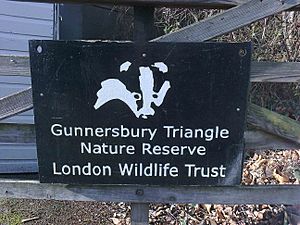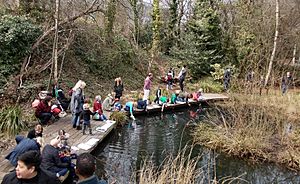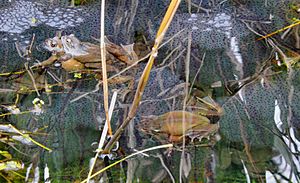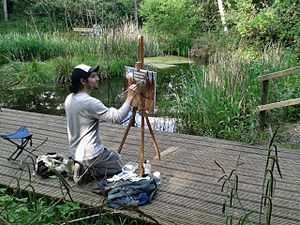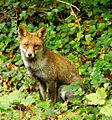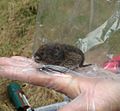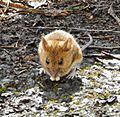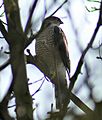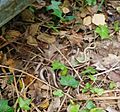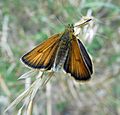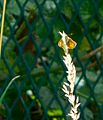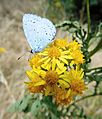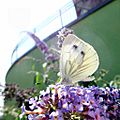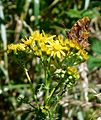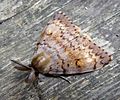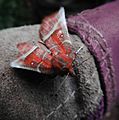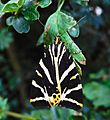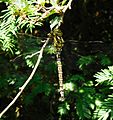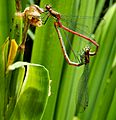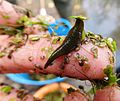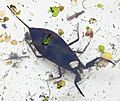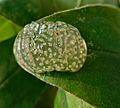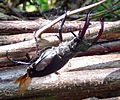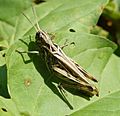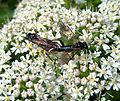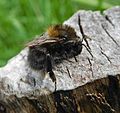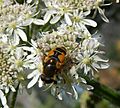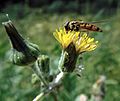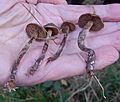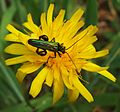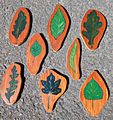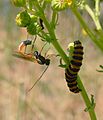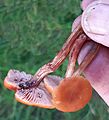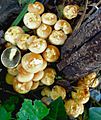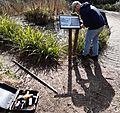Gunnersbury Triangle facts for kids
Quick facts for kids Gunnersbury Triangle |
|
|---|---|
|
IUCN Category IV (Habitat/Species Management Area)
|
|
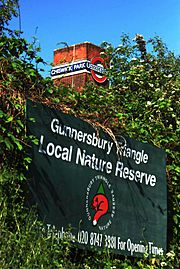 |
|
| Location | Hounslow/Ealing |
| Nearest city | London, England |
| Governing body | London Wildlife Trust |
Gunnersbury Triangle is a special nature reserve in London. It covers about 2.57 hectares (6.3 acres). This amazing green space is located in the boroughs of Ealing and Hounslow.
What makes it so special? In 1983, it was the first time in Britain that a public decision stopped a building project. This happened because the land was so important for nature. The reserve officially opened in 1985.
The area is mostly covered by birch trees. You can also find some rare wet woodlands with willow trees. There's even a small area of acid grassland where an old railway track used to be. Many different plants, birds, amphibians, and insects live here. The London Wildlife Trust helps manage and protect this reserve.
Staff and volunteers from the London Wildlife Trust take care of Gunnersbury Triangle. It is open for everyone to visit. They offer fun activities like wildlife walks and talks. Schools and community groups often visit to learn about nature. Companies also send teams to help with conservation work. You can find the entrance on Bollo Lane, near Chiswick Park Underground station.
Contents
A Special History: Saving Gunnersbury Triangle
Old maps from the 1800s show this area had orchards and gravel pits. The triangle shape of the reserve was formed by three railway lines. Two belonged to the District Railway (now the District line of London Underground). The third was from the London and South Western Railway, which is no longer used.
In the 1940s, people used parts of the triangle as vegetable gardens. But when a railway workshop was built, the bridge into the triangle was left unused. Over time, nature took over. Grasses and trees grew naturally, creating a wild space.
In 1981, there was a plan to build shops and offices on this land. But local people wanted to protect it. The Chiswick Wildlife Group started in 1982 to fight for the reserve. This group later became part of the London Wildlife Trust.
The fight to save Gunnersbury Triangle was one of the first big projects for the London Wildlife Trust. In 1983, a special meeting called a Public Inquiry was held. The decision was to save the land for nature. This was a huge win! It was the first time in the UK that nature conservation won over building plans in a city. Gunnersbury Triangle became an important example for other places.
The London Borough of Hounslow bought the land from British Rail. They got a grant to help pay for it. Since 1985, the London Wildlife Trust has managed the reserve. Both Hounslow and Ealing councils officially named parts of the triangle as local nature reserves.
In 2016, the volunteers at Gunnersbury Triangle won an award. It was called an RE:LEAF Acorn Award. They won it for their great work in protecting trees.
Exploring the Reserve
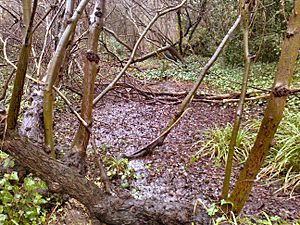
Gunnersbury Triangle is a classic "railway triangle." It's the space between three curving railway lines. To the west, there's the London Overground. To the south, the District line. And to the northeast, an old, unused railway track. Most of the area is now covered in trees. It is a local nature reserve and an important site for nature conservation in London.
Habitats and Wildlife
The reserve has different types of natural areas, called habitats. Each habitat is home to different plants and animals.
Woodlands
- Birch Woodland: This is the biggest part of the reserve. You'll see many Silver birch trees here. There are also some willows, wild cherry, and sycamore trees. Smaller plants like hawthorn, elder, holly, and yew grow underneath. The ground is often covered in thick brambles and ivy. You might also spot ferns like male fern and lady fern.
- Willow Woodland: This is a special wet woodland area, sometimes called the "mangrove swamp." It has different kinds of willow trees. You can find plants like honeysuckle, common horsetail, and yellow flag flowers here.
Grasslands and Meadows
- Eastern Bank and Hedgerow: This area has rough grasses and a hedge. It's a sunny spot, which is great for butterflies. Look for holly blue, Essex skipper, and small skipper butterflies here.
- North Neutral Meadow (Anthill Meadow): This meadow is bumpy because of mounds made by yellow meadow ants. You'll see different grasses and wildflowers like common vetch and white clover.
- North Acid Meadow (Railway Track Acid Grassland): This part is on the old railway track. The ground is sandy and rocky. Small, fine grasses grow here, along with plants like sheep's sorrel.
- Southwest Meadow (Picnic Meadow): This meadow has coarser grasses. You might see broom plants, which grew after a small fire.
Ponds and Water Areas
- Main Pond: This pond was dug in 1986. Its water level changes with the seasons. Many plants grow here naturally, like common reed, purple loosestrife, and yellow iris.
- Small Pond: This pond also changes with the seasons. You can find plants like water plantain and bittersweet here.
Other Areas
- Tall Herb Meadow: This small meadow has tall plants like cow parsley and hogweed. You might even see some daffodils that escaped from gardens.
- Gardens: Near the entrance, there are gardens planted with wildflowers. Hedges with native trees and shrubs grow here too.
- Infrastructure: This includes the hut and sheds used by the reserve staff.
Learning and Fun at the Reserve
Many school groups visit Gunnersbury Triangle. About 1500 students come each year, especially in summer. They learn about grassland, woodland, and pond ecosystems.
The reserve is a great place to see wildlife. You can spot holly blue, peacock, and brimstone butterflies. A sparrowhawk might nest in a birch tree. You might also see jays, bees, and wood-mice. There are open areas for picnics. In autumn, you can even pick blackberries. The goal is to keep it feeling like a wild countryside spot in the middle of the city. Even if you see a train go by, the trees make you feel far away from the busy city.
The reserve is open to everyone. The London Wildlife Trust leads guided tours like "Fungus Forays" to find mushrooms and wildlife walks. On open days, staff and volunteers organize activities for kids and adults. These activities help people learn about nature in a fun way.
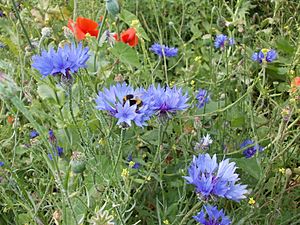
Sometimes, companies send groups of volunteers to help. They do tasks like clearing overgrown plants or fixing paths and fences.
The London Wildlife Trust wants to keep the reserve healthy and full of different plants and animals. They do this by cutting back certain plants, mowing, and removing plants that don't belong. They want to keep the "wild" feeling of the place.
Why Gunnersbury Triangle is Important
Gunnersbury Triangle shows that amazing things can happen for nature, even in busy cities. It proves that you don't need a huge budget if people are willing to work together. These projects help nature and bring communities closer.
Amazing Animals and Plants
The Gunnersbury Triangle is home to a huge variety of living things. Here are just a few examples of the animals, insects, and fungi you might find there:
| Animals You Might See |
|---|
|
Activities at the Reserve
Here are some photos showing the educational and conservation work at the reserve.
| Fun Activities |
|---|
|
Images for kids
-
Muntjac (Muntiacus reevesi) prints
-
Grey heron, Ardea cinerea
-
Speckled Wood, Pararge aegeria
-
Blusher mushroom, Amanita rubescens
-
Fly agaric, Amanita muscaria
-
Sulphur tuft, Hypholoma fasciculare
-
Oyster mushrooms, Pleurotus ostreatus var columbinus
-
Hypholoma fasciculare, sulphur tuft
-
Pestle puffball Handkea (Calvatia) excipuliformis
-
Turkeytail bracket fungus, Trametes (Coriolus) versicolor
-
Lyophyllum ulmarium on ivy-clad elder
-
Redcurrant, Ribes rubrum
-
Borage, Borago officinalis
-
Common vetch, Vicia sativa
-
Garlic mustard, Alliaria petiolata
-
Herb Robert, Geranium robertianum
-
Smooth sow-thistle, Sonchus oleraceus
-
Greater Celandine, Chelidonium majus
-
Oxeye Daisy, Leucanthemum vulgare
-
Tufted Vetch, Vicia cracca
-
Buddleia, Buddleja sp.


